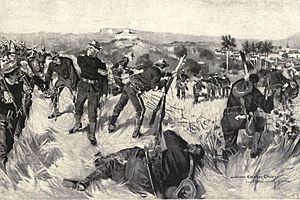Battle of El Caney facts for kids
Quick facts for kids Battle of El Caney |
|||||||
|---|---|---|---|---|---|---|---|
| Part of the Spanish–American War | |||||||
 The Capture of El Caney, Howard Chandler Christy |
|||||||
|
|||||||
| Belligerents | |||||||
| Commanders and leaders | |||||||
| Strength | |||||||
| 18,000 4 field guns |
620 2 field guns |
||||||
| Casualties and losses | |||||||
| 1,300 dead and wounded | 38 killed 138 wounded 160 captured |
||||||
The Battle of El Caney was an important fight during the Spanish–American War. It happened on July 1, 1898. A small group of about 500 Spanish soldiers bravely defended their position for twelve hours. They faced a much larger American force of nearly 7,000 soldiers. This battle slowed down the American plan to attack nearby San Juan Hill. Even so, the Americans moved on to San Juan Hill later that same day. They won both battles, leading to the Spanish forces giving up.
Contents
Why the Battle Happened
The battle took place in El Caney, Cuba. Spanish soldiers were told to protect the northwest side of Santiago de Cuba. About 514 Spanish soldiers and 100 Cubans loyal to Spain were there. They were led by Brigadier General Joaquín Vara de Rey y Rubio. Their job was to hold back the American 2nd Division. This American division was part of the Fifth Army Corps. It was led by Brigadier General Henry Ware Lawton.
The Battle of El Caney
Spanish Defenses and Weapons
The Spanish defenders did not have machine guns. But they had good, modern rifles. These rifles used smokeless powder, which meant no big smoke clouds. They also had two modern 80mm mountain cannons. These cannons also used smokeless ammunition.
The regular Spanish soldiers used fast-firing M1893 7mm Mauser rifles. Other loyal fighters used older, single-shot Remington Rolling Block rifles. These older rifles used black powder, which made a lot of smoke. General Vara de Rey and his small force fought for almost twelve hours. They held back over 6,000 American soldiers. This stopped General Lawton's men from helping the main American attack on San Juan Hill.
American Challenges and Equipment
Some American soldiers faced problems with their weapons. For example, the 2nd Massachusetts had old, single-shot rifles. These rifles used black powder. One soldier said they "received such a shower of bullets." He felt it was like the company might be "wiped out." Because of this, the 2nd Massachusetts was later replaced. Newer troops with better weapons took their place.
The American forces also lacked strong artillery support. Their only Gatling Gun team was sent to help at San Juan Hill. General Lawton's artillery had just four 3.2-inch field guns. These were light cannons that used black-powder ammunition. The American cannons had a short range. Also, each shot made a big cloud of black smoke. This made the gun crews easy targets for Spanish rifle fire.
General Lawton first tried to spread his cannon fire to many targets. This did not work well against the strong Spanish positions. The American attacks kept going, but they lost many soldiers. During the fighting, General Vara del Rey was shot in both legs. As he was being carried away, he and his group came under heavy American fire. General Vara del Rey and some officers, including his son, were killed. His body was found later and buried nearby. Even after his death, the Spanish kept fighting.
Taking the Strongpoints
After an early setback, Lawton changed his plan. He ordered his four 3.2-inch guns to focus fire on one strongpoint. This was a place called El Viso. The cannons successfully broke through the walls of El Viso from about 1,000 yards away.
Then, two U.S. infantry groups attacked. These were the 12th Infantry and the 25th Infantry. After a tough fight, El Viso was captured. Private T. C. Butler was the first American to enter the blockhouse at El Caney. He took the Spanish flag. Once El Viso was taken, the American cannons destroyed each Spanish strongpoint one by one. The fighting ended around 5:00 PM when the remaining Spanish troops pulled back.
What Happened After the Battle
The attack on El Caney was a success, but it had a cost. Attacking two strong places at once, El Caney and San Juan, split the American forces. This caused delays and more soldiers were hurt or killed.
About 185 Spanish soldiers escaped to the north. But General Vara del Rey, his two sons, and his brother died. Colonel Salvador Diaz Ordóñez was one of the Spanish wounded. He was in charge of the Spanish artillery. He also designed the large Ordóñez guns used as coastal artillery in Cuba.
Later, about 400 to 600 Spanish defenders from El Caney tried a counterattack. They attacked American soldiers on Kettle Hill. These American soldiers were from the 3rd Cavalry and the 1st Volunteer Cavalry. A single ten-barrel Gatling Gun on San Juan Hill fired at them. This gun was operated by Sergeant Green. Spanish commanders later said that almost all of the 600 attacking Spanish troops were killed by the Gatling gun fire.
General Vara del Rey's body was moved five months after the battle. A Spanish group found his body where it was buried. They knew it was him by his uniform, long beard, and a large bullet hole in his skull.
Images for kids
See also
 In Spanish: Batalla de El Caney para niños
In Spanish: Batalla de El Caney para niños


